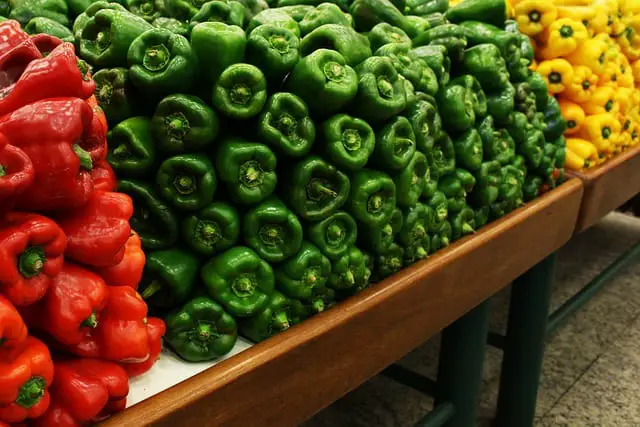Backyard gardens aren’t complete without peppers. Planting these colorful fruits in garden beds (yes, peppers are fruits), which come in green, red, orange, and yellow, adds a splash of color to the garden. Nevertheless, many gardeners are shocked and confused if they find a black-colored pepper in their garden. So why are some peppers turning black? Know what experts have to tell you about ‘why are my peppers turning black?’
There are a few reasons why peppers may turn black, including sunscald, blossom end rot, anthracnose, or bacterial spot, and the specific cause can be identified by examining the affected fruit and plant.
Why Are My Peppers Turning Black?
Peppers usually turn black when they ripen. Unlike some peppers, which change from green to red, other peppers may begin as green, then turn black and finally turn red, orange, or yellow. In addition to turning black during the ripening process, peppers can also turn black due to various other reasons. You may have another reason for your peppers turning black if they don’t show any signs of changing.
During the ripening process, peppers may naturally turn black (or dark purple). Overexposure to direct sunlight or cold temperatures can also turn the skin black. It is more common for pepper varieties, such as jalapenos and some bell peppers, to develop dark purple or black discolorations. Unless they turn black and soft, which indicates disease or blossom end rot, this is normal and should not cause worry. If the pepper’s skin is turning partially purple or black but otherwise appears healthy, it is safe to eat, and the flavor will not be affected.
1. An Ever-Changing Environment
Warm weather is good for peppers. However, late in the growing season, as the temperatures begin to drop, your peppers may suffer some adverse effects from the cooler weather. The exposed parts of a pepper plant can turn black when the temperature drops drastically. Although this can be an eyesore, it does not affect the taste of the pepper.
Blackening can be combated in a few different ways. For example, you can harvest your peppers before the temperatures drop too low. Be attentive to forecasts. It’s best to harvest any peppers you can before the cooler temperatures turn them black if the temperature drops by more than 30° F (16.8° C) within a few days.
2. Diseases Of The Green Pepper
The U.S. Department of Agriculture classifies peppers as perennials in zones 7 through 11. However, peppers grow as annual plants in other parts of the country. The plants thrive in well-drained soil and full sunlight, regardless of annuals or perennials.
About six weeks after they are planted, most pepper types, including bell pepper ( Capsicum annuum ), begin bearing fruit. When fully mature, the fruits gradually enlarge and may remain green or turn yellow, orange, or red, depending on the variety. Pepper plants may be susceptible to diseases that discolour their fruits and cause them to turn black, even though their fruits are usually trouble-free.
3. Fungal Problems With Green Peppers
Green peppers that are ripening can turn black due to various fungal disorders. Pepper fruit can also be affected by anthracnose, which causes round lesions. Black rings sometimes surround the lesions in the center. They can enlarge enough to cover and collapse whole fruits.
Another fungal disease that can cause black areas on pepper fruits is called Phytophthora blight, which eventually covers the whole fruit. Also, pepper plants wilt due to Phytophthora blight, which causes black spots on the stems.
4. Nutritional Deficiencies
Black peppers are also a symptom of nutritional deficiencies. A pepper plant’s flowering and fruiting stages are more dependent on phosphorus. The fruits of pepper plants can turn black if they do not receive enough phosphorus.
The lack of phosphorus in your pepper plants can also cause many other undesirable side effects, such as ugly black spots on the skin. As a result, fruit quality decreases, disease resistance decreases, and stem and root development are negatively affected.
Summary
So, why are my peppers turning black? There’s nothing natural about your peppers turning soft and black or getting tiny black dots. Small black spots on peppers may indicate an infected spot or an insect bite. Blossom end rot can be detected when your peppers’ bottom tips start turning black and soft. Technically, blossom end rot occurs because calcium is deficient, essential for fruit development. Blossom end rot is most frequently caused by inconsistent watering and drought-stressed pepper plants.
Frequently Asked Questions (FAQs)
Is it safe to eat black jalapenos?
It is outstanding to eat black pepper unless it is rotten. At that point, you would not want to consume it. Black peppers are generally hotter than green peppers, so you may want to select black if you prefer a more desirable taste.
When a green pepper turns red, how long does it take?
If the seed packet says six weeks, there is no way to know how long a pepper will take to reach maturity. Though they are still green, peppers might be ready for eating at that time. However, a bell pepper may take two or three weeks more to turn red after maturation.
Is it true that all green peppers turn color?
In some peppers, the color stays green until they mature into yellow or red; in others, it matures into white, lilac, or purple. The color change in ripening peppers is caused by the breakdown of chlorophyll, which occurs when the seeds grow. Peppers can be eaten at any stage, but the study of chlorophyll causes the color change.

Hey, I’m Lisa and I’ve been an avid gardener for over 30 years. I love writing, talking and living in the garden! Feel free to connect with me on my socials below

